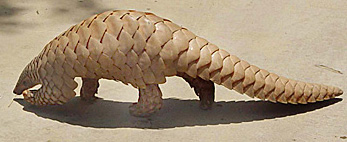Yeahhhh...
Welp, better late than never, eh? I present to you: THE INDIAN PANGOLIN!

The Indian Pangolin (Manis Crassicaudata)
Or Thick-Tailed Pangolin
Conservation Status: Near Threatened
The Indian Pangolin is a Pangolin that lives in the plains and hills of India, Sri Lanka, and some parts of Pakistan. It's not common anywhere in it's range, and is hunted for meat, blood and for making medicinal oil.
The name Pangolin derives from the Malay word "Pengguling", meaning "Something that rolls up". There are eight species of Pangolins alive today, living in parts of Africa and Asia. Pangolins have large Keratin scales covering their skin that are soft when they are young and harden as they age, and are the only mammals with such an odd feature.
Pangolins are nocturnal animals and use their good sense of smell to find insects to eat.

Pangolins were classified with various orders, including Xenartha, which includes Anteaters, Sloths and Armadillos, but new genetic evidence suggests that their closest living relatives are actually in the family Carnivora.
Pangolins can curl up into a ball when threatened, much like an Armadillo, their scales acting as armor and extra defense as they are quite sharp. Their front claws are so long, being meant for digging into termite mounds and climbing, that it is hard for them to walk with them, so they instead walk with their forepaws curled over to protect their claws. Pangolins can also emit a foul smelling acid, similar to the spray of a skunk.

"We keep them alive in cages until the customer makes an order. Then we hammer them unconscious, cut their throats and drain the blood. It is a slow death. We then boil them to remove the scales. We cut the meat into small pieces and use it to make a number of dishes, including braised meat and soup. Usually the customers take the blood home with them afterwards."Pangolin populations have also suffered from illegal trafficking. In May 2007 31 Pangolins were found aboard an abandoned vessel off the coast of china.
The name Pangolin derives from the Malay word "Pengguling", meaning "Something that rolls up". There are eight species of Pangolins alive today, living in parts of Africa and Asia. Pangolins have large Keratin scales covering their skin that are soft when they are young and harden as they age, and are the only mammals with such an odd feature.
Pangolins are nocturnal animals and use their good sense of smell to find insects to eat.

Pangolins were classified with various orders, including Xenartha, which includes Anteaters, Sloths and Armadillos, but new genetic evidence suggests that their closest living relatives are actually in the family Carnivora.
Pangolins can curl up into a ball when threatened, much like an Armadillo, their scales acting as armor and extra defense as they are quite sharp. Their front claws are so long, being meant for digging into termite mounds and climbing, that it is hard for them to walk with them, so they instead walk with their forepaws curled over to protect their claws. Pangolins can also emit a foul smelling acid, similar to the spray of a skunk.

In Pangolins, the section of their brain that relates to problem solving is highly developed, and while this is usually used to find food in the wild, captive Pangolins are extremely good escape artists. Pangolins also lack teeth and the ability to chew, so instead they rip open ant- or termite-hills with their claws and lick the insects out. Some species also use their claws to tear away the bark of certain trees to get to insect nests underneath.
Pangolins reach sexual maturity at two years of age, and the Indian Pangolin usually has one to three babies in a litter.
In Kerala, the Indian Pangolin is called "Eenampechi", in Sinhala it is "Kaballewa" and in Tamil it is the "Azhungu" or "Alangu". The lifespan of any Pangolin in the wild is unknown, but they have been reported to live for as long as 20 years in captivity.
Pangolins reach sexual maturity at two years of age, and the Indian Pangolin usually has one to three babies in a litter.
In Kerala, the Indian Pangolin is called "Eenampechi", in Sinhala it is "Kaballewa" and in Tamil it is the "Azhungu" or "Alangu". The lifespan of any Pangolin in the wild is unknown, but they have been reported to live for as long as 20 years in captivity.
--
Images from Google
[More about Pangolins]
Images from Google
[More about Pangolins]
Well, this was a hard one to put together, seeing as there is little known and even less on the internet about Pangolins, but hopefully I've made someone aware of this crazy little creature and how odd and cool it is.
Until next time, unless I forget, happy odd-animal-hunting!
Until next time, unless I forget, happy odd-animal-hunting!





No comments:
Post a Comment